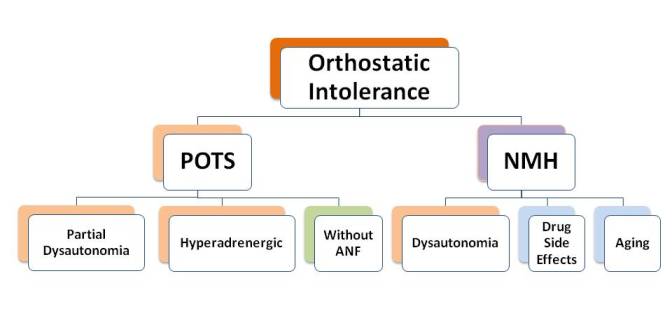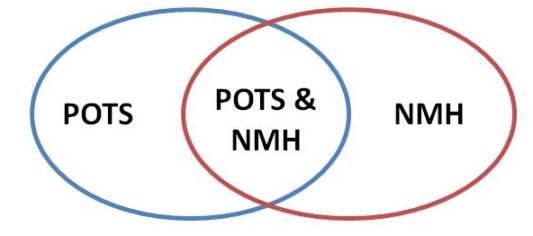Types of Orthostatic Problems Caused By Dysautonomia
Orthostatic Intolerance can cause POTS and Neurally-Mediated Hypotension (NMH). They can happen alone or in the same person, one happens when the person first stands up, the other develops as the person keeps standing. .
POTS and NMH can be caused by autonomic nervous system failure - and there are also other causes of them.

POTS and Neurally-Mediated Hypotension (NMH)
For some people, Postural Orthostatic Tachycardia Syndrome (POTS) is due to a dysfunction of the autonomic nervous system. There are also people with POTS who do not have symptoms or findings of autonomic dysfunction. Orthostatic Hypotension is usually caused by a problem with the autonomic nervous system and is called Neurally-Mediated Hypotension (NMH).(See OH for more details and other causes.)
POTS vs. NMH - Numbers in Children: In a review of children referred for autonomic testing, Sukul and colleagues found that POTS was the most common - found in in 71% of the chilcren.7 (If 100 children were tested, 71 would have POTS. If only 4 were tested, 3 would have POTS). Orthostatic hypotension (NMH) was only present in 5%. (That would be 5 children out of 100 tested.)
Overlap Between POTS and NMH
Some believe these two conditions are not totally separate problems. They may be related to each other: one could be an early change in the system that becomes the other as the damage continues. It is also possible to have both at the same time.
This is all interesting for the clinicians and researchers to consider. But for our purposes, the conditions that cause orthostatic symptoms when you stand up are managed pretty much the same, whether they meet criteria to be called POTS or NMH.

Types of ANS Failure (Dysautonomia) - Primary and Secondary and the medical conditions that are involved. ![]()
References
- Medow MS, Stewart JM, Sanyal S, Mumtaz A, Stca D and Frishman WH. Pathophysiology, Diagnosis, and Treatment of Orthostatic Hypotension and Vasovagal Syncope. Cardiology in Review 2008;16(1):4-20. Abstract
- Thieben MJ, Sandroni P, Sletten DM, et al. Postural orthostatic tachycardia syndrome: The Mayo Clinic experience. Mayo Clin Proc. 2007;82:308–313. Abstract.
- Stewart JM. Chronic orthostatic intolerance and the postural tachycardia syndrome (POTS). J Pediatr. 2004;145:725–730. Article PDF
- Stewart JM, Medow MS, Alejos JC. Orthostatic Intolerance.2011. Medscape article.
- Rowe, Peter. Managing Orthostatic Intolerance. Webinar. September 1, 2010. Hosted by CFIDS Association of American. Accessed June 1, 2012. Written material. Slides PDF. Video.
- Moya. Guidelines for the diagnosis and management of syncope (version 2009). European Heart Journal (2009); 30: 2631-2671. Abstract. Article PDF.
- Sukul D, Chelimsky TC, Chelimsky G. Pediatric autonomic testing: retrospective review of a large series.Clin Pediatr (Phila). 2012 Jan;51(1):17-22. doi: 10.1177/0009922811415102. Epub 2011 Aug 25. Abstract.
Author: Kay E. Jewell, MD
Page Last Updated: August 28, 2012
